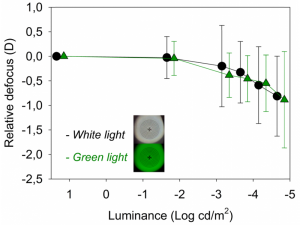ABSTRACT
Purpose
Eyes with distant objects in focus in daylight are thought to become myopic in dim light. This phenomenon, often called “night myopia” has been studied extensively for several decades. However, despite its general acceptance, its magnitude and causes are still controversial. A series of experiments were performed to understand night myopia in greater detail.
Methods
We used an adaptive optics instrument operating in invisible infrared light to elucidate the actual magnitude of night myopia and its main causes. The experimental setup allowed the manipulation of the eye’s aberrations (and particularly spherical aberration) as well as the use of monochromatic and polychromatic stimuli. Eight subjects with normal vision monocularly determined their best focus position subjectively for a Maltese cross stimulus at different levels of luminance, from the baseline condition of 20 cd/m2 to the lowest luminance of 22×10−6 cd/m2. While subjects performed the focusing tasks, their eye’s defocus and aberrations were continuously measured with the 1050-nm Hartmann-Shack sensor incorporated in the adaptive optics instrument. The experiment was repeated for a variety of controlled conditions incorporating specific aberrations of the eye and chromatic content of the stimuli.
Results
We found large inter-subject variability and an average of −0.8 D myopic shift for low light conditions. The main cause responsible for night myopia was the accommodation shift occurring at low light levels. Other factors, traditionally suggested to explain night myopia, such as chromatic and spherical aberrations, have a much smaller effect in this mechanism.
Conclusions
An adaptive optics visual analyzer was applied to study the phenomenon of night myopia. We found that the defocus shift occurring in dim light is mainly due to accommodation errors.


